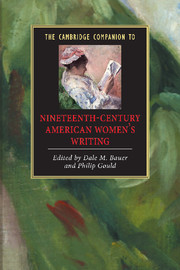2 - Women in public
from Part I - Historical and theoretical background
Published online by Cambridge University Press: 28 May 2006
Summary
Introduction: separate spheres
The notion of “the separate spheres” has been used for over a century to endow emerging cultural hierarchies with the obviousness of gender (male/ female) opposition: elite literature v. popular literature; high culture v. mass culture; professional and market culture v. domestic culture; business-place competition v. sentimental equality; public sphere rationality v. domestic feeling. These multiple, seemingly rigid definitions for various complementary and/or oppositional practices have long informed our study of nineteenthcentury women's literature and the historical contexts that shaped its concerns in the United States.
The logic of difference and even opposition supplied by the notion of “separate spheres” has funded a feminist focus on women’s lives, women’s politics and women’s literature since the 1960s. Reacting to historical and literary models that overwhelmingly deemed women’s lives irrelevant to larger historical matters, this newer generation of women academics historicized and theorized a “world of women” that allowed us to appreciate nineteenth-century women’s world, their domestic perspectives, their values, and their social and political subversiveness and opposition. Feminist historians returned to one of the most powerful early descriptions of United States democracy, Alexis de Tocqueville’s Democracy in America, and in particular, his celebration of “The Young [American] Woman as Wife” (1835, 1840).
- Type
- Chapter
- Information
- Publisher: Cambridge University PressPrint publication year: 2001
- 2
- Cited by

